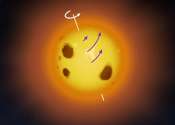Researchers investigate coronal mass ejection on the star AB Doradus
Researchers from Leiden University in the Netherlands have conducted a study of coronal mass ejections on a young solar-type star known as AB Doradus. Results of the new research, published August 1 on the pre-print server ...









